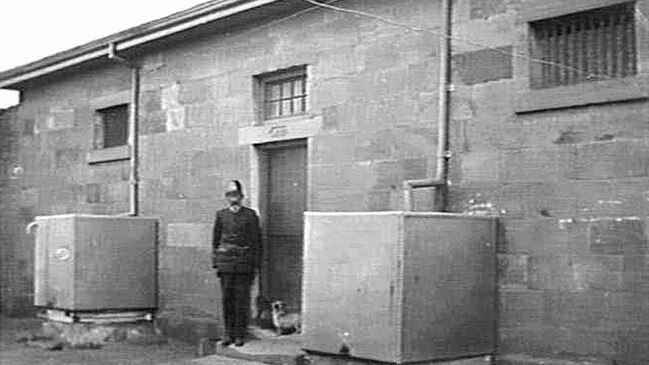Green tent murder one of goldfields’ most shocking crimes
A stranger with a dead eye sent a shudder through anyone his glare fell upon as he swept through Victoria’s goldfields in the 1850s. So when he became fixated with a young widow, tragedy was in the offing.

Melbourne
Don't miss out on the headlines from Melbourne . Followed categories will be added to My News.
An unspeakable crime on the goldfields, known as the green tent murder, led police to a travelling robber with an unforgettable stare.
The green tent, operated by Elizabeth Matheson and her husband, was like a convenience store for the goldfields.
By the late 1850s the portable structure was a favourite resort for miners, who could find anything from equipment to horse feed and hot meals within the canvas.
As it prospered, the store set up permanently near Meredith and when a travelling jeweller visited, Elizabeth bought a pair of dazzling green jade earrings.
Her husband, an American, departed with cash on a trip to buy a horse and cart as the business expanded.
He never returned and was later found dead, his skeleton wedged in a hollow tree with none of the money he had departed with.
The widowed Elizabeth, aged 27 and with two young children, carried on with the green tent and men from the goldfields helped her make a stronger, more permanent structure.
Women on the goldfields were rare and the attractive Elizabeth was well liked.

That was when the man with big feet and a dead eye started visiting.
He was unmistakable. An Irishman in his late 20s, the glare from his one good eye, contrasted by its pale neighbour, made women shudder when he stared.
And Owen McQueeney liked to stare.
After he had lingered in the green tent around Elizabeth during one of his lengthy visits, she said to a neighbour that it felt like she was wearing nothing whenever he looked at her.
The unwelcome itinerant’s oversized feet were as large as his strange aversion to tea.
Whenever the drink was served he ardently refused it.
The odd man’s visits to the green tent became more frequent, and lengthy.
McQueeney asked for obscure items and when Elizabeth told him they were not in stock, he spent hours in the store searching for them.
He started having his meals served in the green tent.
He showed her two pistols and demanded she buy one, insisting it would be for her protection.

Other patrons noted that Elizabeth seemed resigned to the visits and would quietly attend McQueeney’s every request.
She was afraid of him.
It came to a tragic end early one Saturday morning.
A revenue officer, passing the green tent, noticed an unusual odour in the smoke passing from the chimney.
Finding the door locked, he forced it open.
There was Elizabeth, dead in a chair by the fireplace with an horrific pistol wound to the face.
A physician would later testify the bullet, fired at close range, had passed right through her head, totally removing an eye and killing her instantly.
It had recently rained, and there was one distinct set of footprints leading from the tent to the wilderness, found by authorities with the help of an aboriginal tracker.
The prints were made by a man with large feet.
The regular customers at the green tent all told police the same thing: find the Irishman with big feet and a dead eye who seemed to always stick around but, now, was suspiciously and suddenly absent.
Soon, witnesses on the road had told of the distinct McQueeney making off with a large swag towards Geelong, where he was eventually found when a landlady described to police a guest who hated tea.

McQueeney, who was revealed as a travelling robber and fraud, denied the killing at Meredith.
But eventually the police had a break.
McQueeney had passed on to another criminal two pieces of jade that looked exactly like the ones that had hung on Elizabeth’s earrings.
Exhuming her body, authorities found the earrings had been ripped off.
At trial, McQueeney personally argued with almost everyone who spoke against him.
He questioned the credibility of the physician’s evidence and made pot shots at witnesses who described his infatuation with the green tent and his victim.
The arrogant killer never believed he would hang.
MORE MELBOURNE HISTORY
INSIDE SLUMS OF 1930s MELBOURNE
WHEN AMPUTEE THUGS TERRORISED CITY
THE SAD TALE OF BRIGHTON MANSION
He believed a public aversion to capital punishment and just enough obfuscation of the facts would be enough to see him walk free.
He was wrong.
Convicted under the weight of evidence, he was sentenced to die in Geelong in October 1858.
McQueeney argued all the way to the noose.
He even berated the executioner, like he had berated witnesses in court, and bickered that he was being held too tightly and that the hood was pulled over his face too soon.
The complaints came to a sharp end when the hatch opened and Owen McQueeney’s big feet swung.
Green Tent Rd, off the Midland Hwy just south of Meredith, was named for the old store, and the heinous act that became known as the green tent murder.
